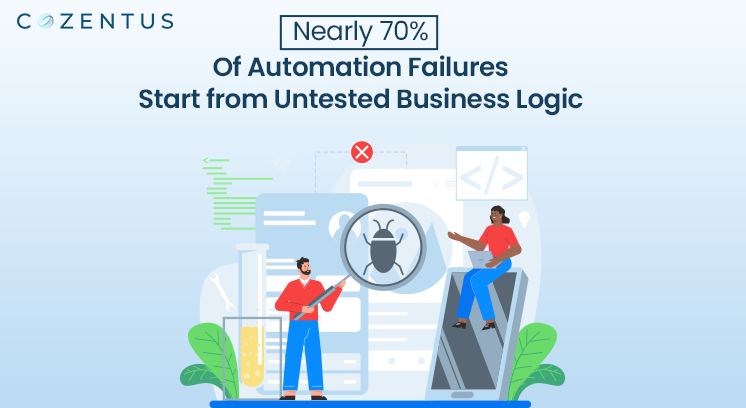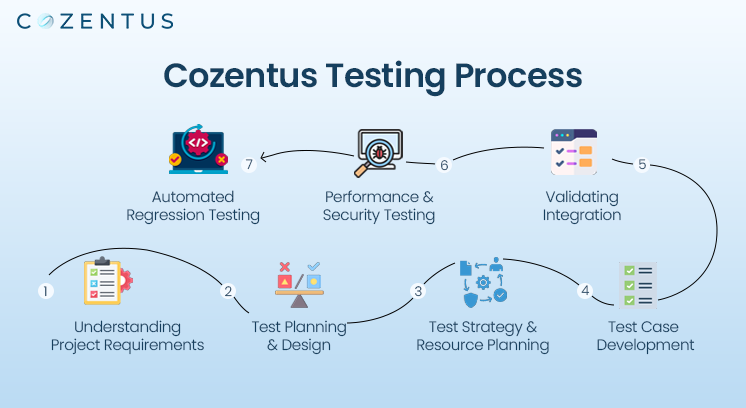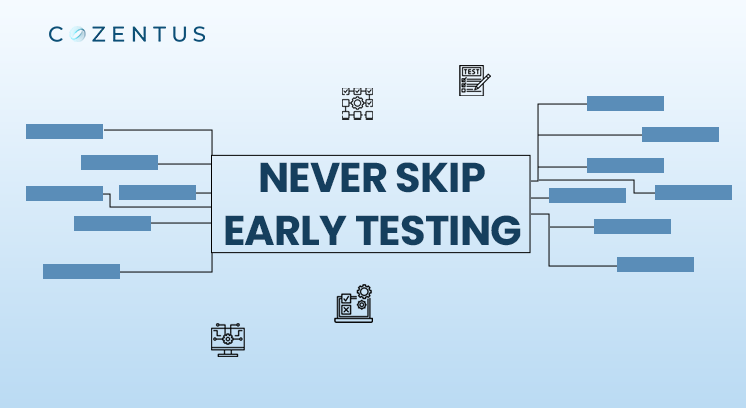The Real Cost of Skipping Testing
Most teams don’t skip testing because they want to. They skip it because they’re rushing to launch, to integrate, or to show progress. But what really happens next is that things work fine in the demo, then start breaking in production. Reports don’t sync, data looks off, and everyone ends up asking, “Didn’t we test this?”
In our work with global enterprises and logistics providers, we’ve seen one pattern repeatedly: that projects fail not because of bad technology, but because testing wasn’t given the appropriate time and depth it deserved. Testing isn’t a stage before “go-live.” It’s what makes “go-live” successful.
At Cozentus, we call it testing with intent. Because when you test like you mean it, you prevent months of rework, confusion, and frustration.

What Happens When You Don’t Test Early
Skipping proper testing doesn’t just cost you time. It breaks trust, both internally and externally.
When systems don’t work properly, customer experience is the first one that goes down. Then come the operational bottlenecks, misreported KPIs, and problem-solving that takes valuable hours of the team.
A single error in an automation loop or faulty API can lead to:
- Weeks of downtime during fix cycles
- Lost revenue from missed transactions
- Inaccurate analytics, which impacts decision-making
- Frustrated teams, who keep on working manually
Testing, on the other hand, builds predictable systems, which is the most underrated asset in digital transformation.
At Cozentus, we often tell our clients, “Testing is cheaper than regret. And much faster than recovery.”
What Happens When You Test Before Integration
Today’s systems are interconnected like never before. Your ERP talks to your CRM. Your supply chain data feeds analytics dashboards. Your automation tools depend on clean inputs from multiple APIs.
But with every new connection, there’s a new risk.
A single mismatch in how two systems exchange data can break an entire workflow. An automation rule written for one process might make errors somewhere else. And if you find that out after integration, it’s already too late.
That’s why pre-integration testing is so powerful. It helps you:
- Validate how systems interact before they go live
- Check that data flows correctly and stays consistent
- Simulate real-world conditions without risking production environments
- Build confidence that integration will actually work as you expect it to
A Real-Life Example: When Testing Saves A Business
A logistics provider was launching a new shipment visibility platform that connected multiple carrier APIs. On paper, it looked perfect. It had everything, like real-time updates, smart dashboards, and automated alerts.
But during early testing, we found mismatched data formats, duplicate entries, and latency issues between certain APIs.
Instead of patching problems after go-live, the team fixed them during testing. As a result, it saved months of post-launch troubleshooting.
The outcome?
- When the platform launched, it just worked.
- Clients got real-time updates without disruption.
- The company scaled confidently because they trusted their system.
That’s the power of testing before integration.
Testing Helps you Find the Right Alignment – Not Just Bugs
One of the biggest misconceptions about testing is that it’s only about catching defects. But in reality, testing is mostly about alignment. It makes sure every piece of your technology fits the way it’s supposed to.
At Cozentus, we often remind teams that “integration” is not just connecting software. It’s about connecting logic, processes, and data models.
Testing ensures that all of those work in sync - from front-end applications to backend databases. It tells you whether your automation logic matches your business goals, whether your integrations scale when real load is applied, and whether your data is clean and can be used.
Good testing means fewer surprises later. And in business, having this clarity is peace of mind.
Automation without Testing is a Recipe for Failure
Automation is powerful, but without testing, it’s like driving fast at night without the lights. If your automated process runs on incomplete or inconsistent rules, it can spread errors faster than humans ever could.
We’ve seen cases where automated invoice validation rules don’t read the data properly because of a missing test scenario. This leads to thousands of incorrect transactions.
That’s why testing comes before automation, not after. Testing ensures that what you automate is accurate, efficient, and can be repeated. At Cozentus, our AI-driven test automation models predict potential points of failure even before deployment. This helps teams to fix proactively, which reduces both downtime and operational risk.
Before automating, ask:
- Have we validated each workflow logic?
- Do we have consistent data definitions?
- Have we tested failure recovery scenarios?
If the answer is “no,” your automation isn’t ready yet.

Scaling without Testing is Like Building on Sand
Scaling feels exciting at first. New customers, bigger volumes, and more users. But as systems grow, so does their complexity.
A process that works with 10 users may not work with 1,000. A database query that runs in 2 seconds might take 20 seconds under real-world load.
Without performance and scalability testing, you’ll only find these limits when things start failing.
At Cozentus, we help organizations simulate scaling scenarios before they happen. We test how systems behave under heavy data loads, concurrent transactions, or rapid-fire requests. We make sure your infrastructure can handle tomorrow’s growth, along with today’s traffic. Because scaling without testing isn’t growth. It’s gambling with your business.
Testing That Aligns with Business Goals
At Cozentus, we approach testing from a business-first lens. It’s not just about software, it’s about how technology supports your goals.
That’s why our testing services cover every layer of the ecosystem:
- Functional and Regression Testing — to ensure systems do what they should.
- Integration and API Testing — to validate seamless data flow.
- Performance and Scalability Testing — to prepare for growth.
- AI-driven Test Automation — to make testing faster and more intelligent
- Continuous Testing — to maintain quality with every release
Our approach combines domain understanding with automation. This ensures that every test case is of real operational scenarios, especially in industries like logistics, manufacturing, and finance, where precision matters a lot.
Conclusion: Testing Builds Trust and Trust Builds Growth
Trust that your systems work. Trust that your teams can deliver. Trust that your customers will get what they expect.
When technology runs smoothly, people stop worrying about “what might break” and start focusing on “what’s next.” That’s when real growth happens.
Technology is evolving fast. integrations, automations, and scaling decisions happen every day. But success doesn’t come from moving fast. It comes from moving correctly.
So, before you integrate, automate, or scale - take a step back and test like you mean it.
Want the best testing team? Here’s who you call
Recent Post
Subscribe to our newsletter
Stay updated on latest trends and news in the supply chain and logistics industry








